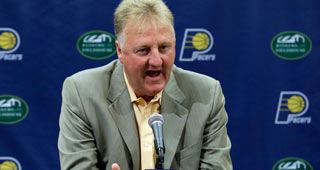With Paul George rounding back into form, the Indiana Pacers rebounded from a down year and returned to the postseason. While it wasn’t the stifling unit it had been when the Pacers were challenging the Heat in the Conference Finals, the defense was back and third in the league. The offense was improved as well, including playing at a faster pace than previous seasons.
As mentioned, Indiana’s best development was George returning to his All-NBA self by the end of the season. He was the best player on the floor as the Pacers pushed the Raptors to seven games in the first round. George is signed for three more seasons (the last being a Player Option) at less than the max. To have a player of his caliber locked up for less than the max is an advantage very few teams have, outside of players on Rookie Scale contracts.
Speaking of players on Rookie Scale deals, the Pacers' next best asset is Myles Turner, their young PF/C. Turner is coming of an impressive rookie year where he scored 10 PPG to go with 5.5 RPG and 1.4 blocked shots per game in just under 23 MPG. Having just turned 20 years old in March, he was a solid defender and showed impressive range on his jump shot. The Pacers have their long-term frontcourt piece to complement George in Turner.
The rest of the Pacers franchise is a bit of a question mark, starting on the sidelines. After a successful five-year run, Larry Bird decided it was time to move on from Frank Vogel. While acknowledging Vogel’s success, Bird also expressed a desire for the team to go small more often (something Vogel wasn’t willing to do) and to play faster. That is an admirable direction, but it made the subsequent coaching hire that much more curious. Nate McMillan had good success in both Seattle and Portland, but his teams often ranked at the very bottom of the league in pace. Until this point, McMillan has preferred to play a deliberate style that maximizes possessions, controls the ball and allows his team to set their defense. It remains to be seen if he can and will adapt to the style of play the front office seems to want to move towards.
As far as the roster goes, the Pacers are in transition. Monta Ellis joins George in being signed for three seasons, the last of which is also a Player Option. For all his talents as a scorer, Ellis remains an inefficient shooting guard in a point guard’s body. His three-point shot remains iffy at best and as he ages, he is getting to the FT line less and less. At this point in his career, Ellis best suited to coming off the bench in a sixth man, scoring role.
Unfortunately for Indiana, Ellis remains the best option to start at SG at this time. Rodney Stuckey is ill suited for a starting role and C.J. Miles is better at SF or coming off the bench. In addition, George Hill is not a traditional PG, so the SG needs to do a fair share of ball handling for the Pacers. Hill continues to be a solid defender though, and effective without the ball. He can defend both guard positions and is comfortable switching on to small forwards as well. On the offensive end, Hill has developed into one of the more consistent three point shooters in the league. The Pacers are have benefited from his steady hand for five seasons, but Hill enters the final year of his contract this year. He’s now also 30 years old, and while he’s showing no signs of slippage in his play, the Pacers could look for an upgrade.
Up front, behind George and Turner the Pacers have some question marks. Lavoy Allen is under contract for next season and he’s been a dependable reserve/spot starter. If he’s a big part of your starting unit however, you’re not likely to have a very good season. Allen should be playing 15-20 MPG off the bench and filling in where necessary.
No other big that can be relied on for rotation minutes is signed for next season. Ian Mahinmi, Jordan Hill and Solomon Hill are all free agents. Mahinmi picked a great time to have a career year. He was a starter for the first time and responded with career highs across the board. While his overall defense slipped a touch with more minutes and responsibilities, his improvement offensively more than made up for it. Mahinmi will be 30 years old at the start of next season, so spending big on him may not be wise. However, he has played sparingly most of his career, so he should have plenty of miles left in him. And with rim protecting bigs at a premium across the league, Mahinmi is in for a big pay day.
Jordan Hill and Solomon Hill are both likely to move on albeit for different reasons. Jordan Hill suffered lapses on both ends at the most inopportune time and by the end of the season he was out of the rotation entirely. The Pacers will likely renounce him to free up the extra cap space.
Solomon Hill had his Rookie Scale option declined for next season. In the postseason, he was arguably the Pacers third most consistent player behind George and Turner. Declining a Rookie Scale option year is never a recommended path, unless the player has proven he can’t play at all. Hill was coming off a good sophomore season where he started most of the year in place of George at the time his option was declined, so it made even less sense. With the cap jumping, Rookie Scale deals are an even bigger bargain than they normally are. By declining his option, the Pacers are limited to paying Solomon Hill only what his salary would have been had the option been picked up. As a potential 3&D wing, always in demand around the NBA, and with so much available money this summer, Hill will likely get paid more than the Pacers can possibly match.
In the offseason the Pacers will need to look to upgrade around the returning players. With a projected $20 million in cap space, the opportunity is there for Indiana to add some nice pieces. They’d like Mahinmi back to anchor the C position, and a deal starting around $10-12 million annually would be ideal. The bidding may drive higher given his skill set and the Pacers will have to decide how far they want to extend themselves. Turner is in the fold and plays the same positions and is already a better option offensively. If Mahinmi moves on, expect versatile bigs like Ryan Anderson, Joakim Noah, Marvin Williams, or David Lee to be targets. All bring something different, but can fit in the up tempo scheme the team hopes to implement. If the Pacers opt for a pure center who can offer some rim protection Cole Aldrich or Timofey Mozgov could both fit nicely next to Turner.
With the holes up front and depth in the backcourt and on the wing, the Pacers aren’t likely to spend much to upgrade there. A veteran backup for George Hill would be nice, and options abound this summer. The Pacers won’t spend big, but expect to see someone brought in to push Stuckey and Joe Young.
With a new coach, a well-known desire to play smaller and faster and plenty of cap space, Indiana makes for an interesting watch this summer. They have building blocks in George and Turner that are tough for any team to match in terms of skill and potential. Getting the right pieces around them will go a long way to getting the Pacers back to competing with LeBron James and the Cavaliers at the top of the Eastern Conference.
Offseason Details
Guaranteed Contracts (9): Lavoy Allen, Rakeem Christmas, Monta Ellis, Paul George, George Hill, C.J. Miles, Rodney Stuckey, Myles Turner, Joseph Young
Partial/Non-Guaranteed Contracts (2): Glenn Robinson III, Shayne Whittington
Potential Free Agents (4): Jordan Hill (UFA), Solomon Hill (UFA), Ty Lawson (UFA), Ian Mahinmi (UFA)
“Dead” Money on Cap (0): None
First Round Draft Picks: # 20
Maximum Cap Space: $33,139,581
Projected Cap Space: $20,550,713



